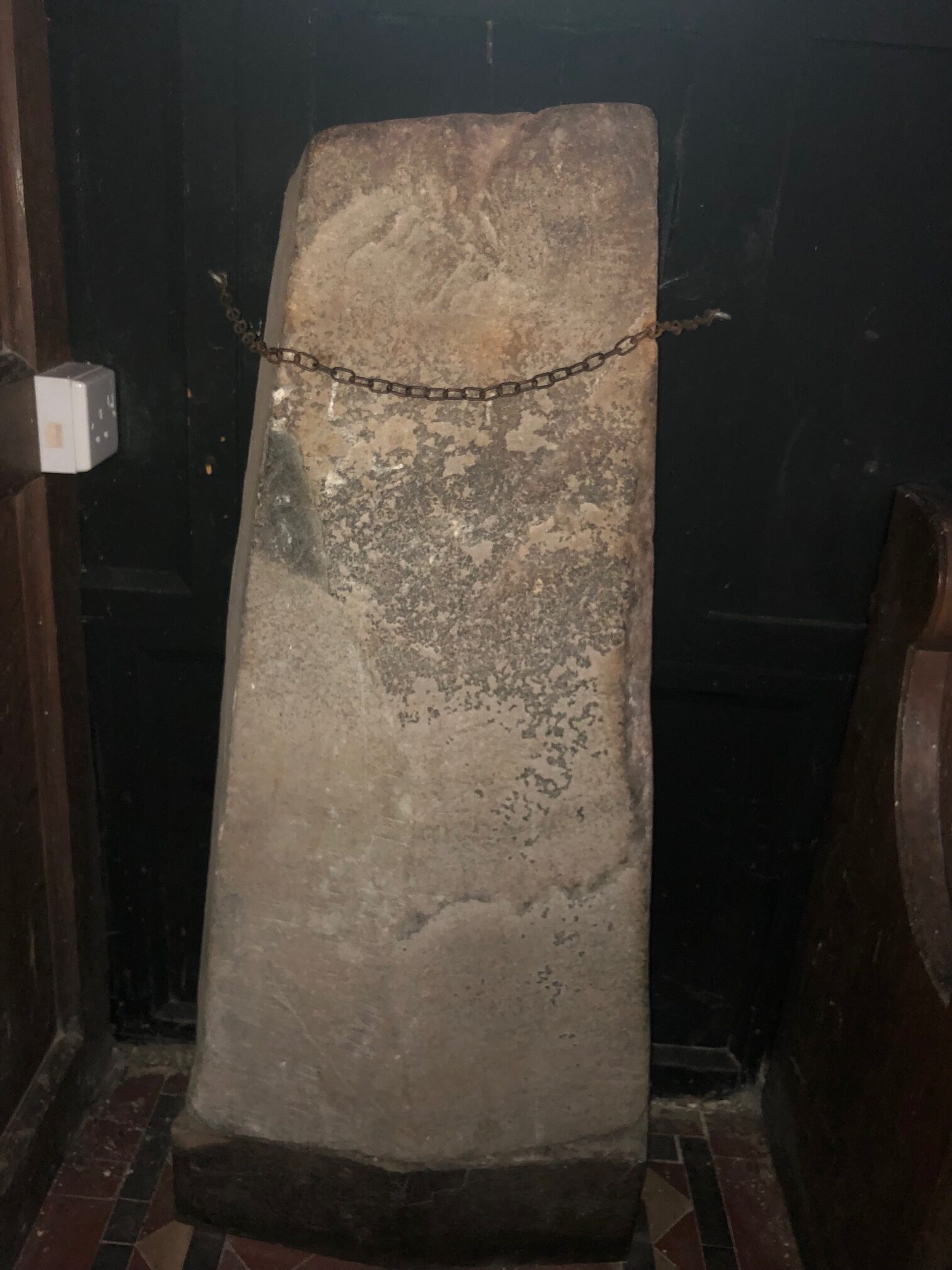
This week I finally managed to get to St Illtud’s Church in Llanelltyd, near Dolgellau, and see for myself the stone, just over three feet tall and chained up like a dog, that sits on a low plinth at the west end of the nave. In the dim light it’s very difficult to make out what’s inscribed on the front of the stone, even with a torch. You have to rely on the interpretations of scholars in the past to understand what’s there: an inscription in Latin, dated to the twelfth century, and an accompanying carving of a human foot.
Here is the transcribed inscription, followed by the translation offered by W.J. Hemp and C.A. Ralegh Radford in 1953:
VESTIGIU[M] KENVRIC TENETUR IN CAPITE LAPIDIS ET IPSEMET ANTEQUAM P[ER]EGRE PROFECTUS EST
The mark [footprint] of Kenvric is affixed on the top of the stone and he himself is bound [by his vow made] before he set out on his journey.

Sure enough, on the flat base the sculptor has incised the outline of a human foot. No other ‘stone foot’ like this survives from medieval Wales, and they seem to be rare elsewhere.

When was the stone inscribed, and who was Cynwrig (Kenvric)? Hemp and Radford date the inscription tentatively to the mid-twelfth century, from a study of the letter forms, which seem to be influenced by post-Norman Conquest manuscript practice. They identify a man called Cynwrig in the historical record (conveniently, in the mid-twelfth century): a son of Owain Gwynedd who was handed over with his brother Hywel by his father to Henry II as a hostage. (Henry, not the gentlest of English kings, later ordered them to be blinded and mutilated when his military campaign in Wales failed.) This Cynwrig, Hemp and Radford suggest, had the inscription, and his foot, left on the stone to commemorate his departure as a hostage.

This theory seems very unlikely. The historic Cynwrig has no connection with Meirionydd, or Cymmer Abbey, just across the river from Llenelltyd. Would he really have the time to order the carving to be made if he was about to be delivered as hostage? And what about the oath? If he was a hostage, taken against his will, why would he make an oath, and what would it concern?

There were other Cynwrigs about at the time, many unrecorded (Cynwrig is not an unusual man’s name). It seems likely that our Cynwrig was not a prince’s son but a pilgrim, about to start on a journey to one of the traditional pilgrimage destinations, either abroad (Jerusalem or Rome, for example) or in Wales (maybe Holywell or Bardsey). The word ‘peregre’ means ‘far away’ in medieval Latin, but it can also carry the additional meaning of ‘as a pilgrim’ (‘peregrinus’ in Latin). If Cynwrig were embarking on a pilgrimage to a distant place, it would be natural for him to do so after taking a solemn pledge to do so, and to record, on the stone, both the pledge and the beginning of his journey.
There were many reasons for deciding to make a pilgrimage: to seek a cure for an ailment or disability, give thanks for health restored, make amends for sins committed, or increase the chances of salvation after death. The encounter with the saint at his or her shrine was the critical feature of any pilgrimage, but almost as important was the journey, and the physical effort needed to make it. Unless they were well-off, pilgrims would normally walk. It’s possible that Cynwrig’s footprint was metaphorical, a symbol for ‘making a journey’. But I’d like to think that he really was making his journey on foot, and that his ‘stone foot’ is a direct and literal memorialisation of his own first step towards his distant destination.
If this is right, Cynwrig stands as one of the earliest named ‘walkers’ known in Wales.
W.J. Hemp and C.A. Ralegh Radford, ‘The Llanelltyd stone’, Archaeologia Cambrensis, vol. 102, 1953, p.164-8.

Leave a Reply